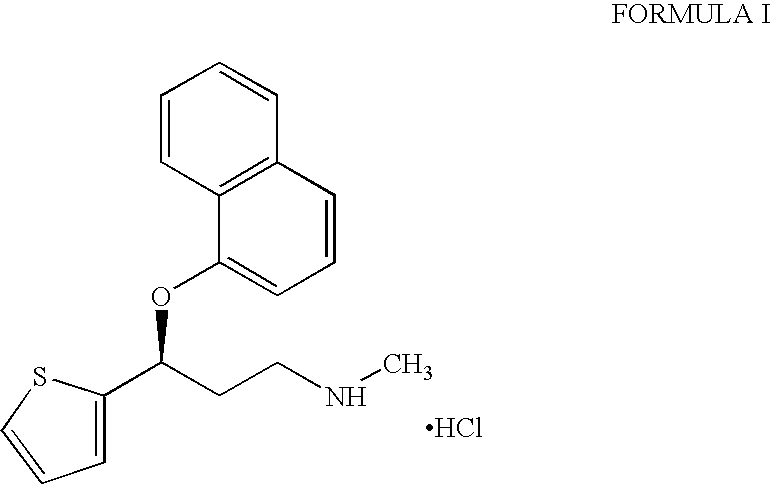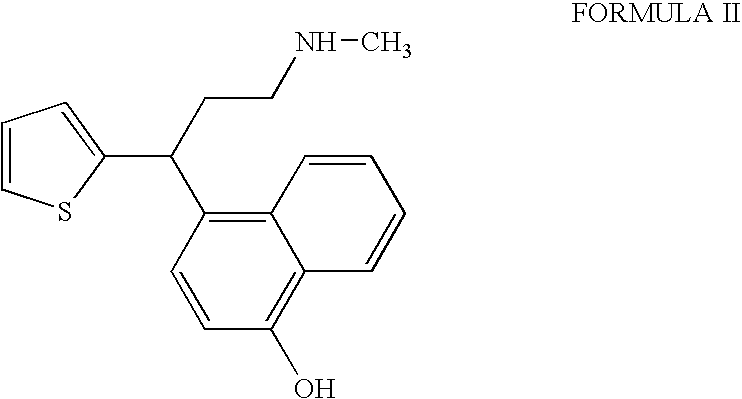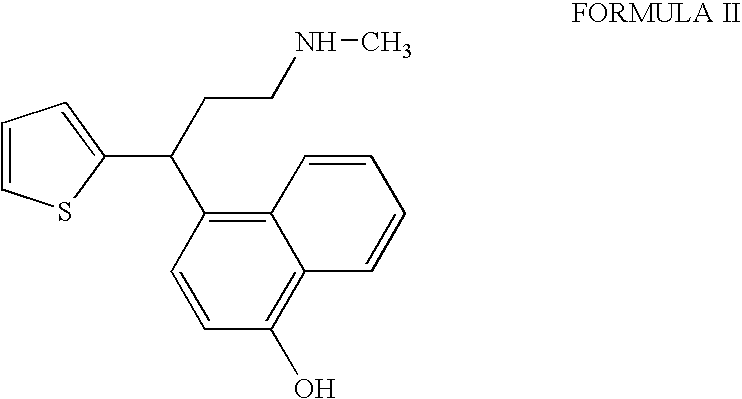Process for the preparation of pure duloxetine hydrochloride
a technology of duloxetine and hydrochloride, which is applied in the field of process for the preparation of pure duloxetine hydrochloride, can solve the problems of tremendous reduction of the quantity of solvent which needs to be used, and achieve the effects of reducing and increasing the content of residual hydrochloric acid
- Summary
- Abstract
- Description
- Claims
- Application Information
AI Technical Summary
Benefits of technology
Problems solved by technology
Method used
Image
Examples
example 1
Preparation of Duloxetine Hydrochloride and Isolation of 4-[3-(methylamino)-1-thiophen-2-ylpropyl]naphthalen-1-ol
A) Preparation of Duloxetine Hydrochloride:
[0024]Sodium hydroxide solution (30% w / v; 100 ml) was added to a stirred suspension of duloxetine maleate (105 g; 0.254 mole) in a mixture of toluene (1.05 L) and deionised water (1.05 L) at about 25° C. to attain a pH of 11 to 12. The mixture was stirred for 10 minutes. Toluene layer was separated and aqueous layer was subsequently extracted with toluene (525 ml). The combined toluene layer was washed with deionised water (2×525 ml) and concentrated under vacuum to obtain duloxetine free base as an oily mass. The duloxetine free base so obtained was stirred in ethyl acetate (472.5 ml) and ethyl acetate—hydrochloric acid solution (140 ml; 0.276 mole; 8% w / w; 1.1 mole equivalent) was added to the stirred solution at 15° to 20° C. The mixture was stirred at 15° to 20° C. for 30 minutes, at 20° to 25° C. for 2 hours and subsequently...
example 2
Preparation of Pure Duloxetine Hydrochloride
[0033]Sodium hydroxide solution (30% w / v; 150 ml) was added to a stirred suspension of duloxetine maleate (200 g, 0.484 mole) in a mixture of toluene (2.0 L) and deionised water (2.0 L) at about 25° C. to attain a pH of 11 to 12. The mixture was stirred for 10 minutes. Toluene layer was separated and aqueous layer was extracted with toluene (1.0 L). The combined toluene layer was washed with deionised water (2×1.0 L) and concentrated under vacuum to obtain duloxetine free base as an oily mass. The duloxetine free base so obtained was stirred in ethyl acetate (1.0 L) and ethanolic hydrochloric acid (65.46 g; 0.484 mole; 27% w / w; 1.0 mole equivalent) was added to the stirred solution at 15° to 20° C. The mixture was stirred at 15° to 20° C. for 30 minutes, at 20° to 25° C. for 2 hours and subsequently at 5° to 10° C. for 2 hours. The solid was filtered and subjected to running wash with ethyl acetate (1×200 ml) followed by slurry wash with e...
example 3
Preparation of Duloxetine Hydrochloride
[0038]Sodium hydroxide solution (30% w / v; 15.5 ml) was added to a stirred suspension of duloxetine maleate (20 g, 0.0484 mole) in a mixture of toluene (200 ml) and deionised water (200 ml) at 150 to 20° C. to attain a pH of 12. The mixture was stirred for 10 minutes. Toluene layer was separated and aqueous layer was extracted with toluene (100 ml). The combined toluene layer was washed with deionised water (2×100 ml) and concentrated under vacuum to obtain duloxetine free base as an oily mass. The duloxetine free base so obtained was stirred in ethyl acetate (140 ml) and ethanolic hydrochloric acid (8.52 g; 0.063 mole; 27% w / w; 1.3 mole equivalent) at 10° to 15° C. The mixture was stirred at 10° to 15° C. for 30 minutes and subsequently at 20° to 25° C. for 3 hours. The reaction mixture was divided into two parts namely Part A and Part B.
[0039]The precipitated solid from Part A was filtered and dried under vacuum at 40° to 45° C. to provide the...
PUM
| Property | Measurement | Unit |
|---|---|---|
| temperature | aaaaa | aaaaa |
| pH | aaaaa | aaaaa |
| pH | aaaaa | aaaaa |
Abstract
Description
Claims
Application Information
 Login to View More
Login to View More - R&D
- Intellectual Property
- Life Sciences
- Materials
- Tech Scout
- Unparalleled Data Quality
- Higher Quality Content
- 60% Fewer Hallucinations
Browse by: Latest US Patents, China's latest patents, Technical Efficacy Thesaurus, Application Domain, Technology Topic, Popular Technical Reports.
© 2025 PatSnap. All rights reserved.Legal|Privacy policy|Modern Slavery Act Transparency Statement|Sitemap|About US| Contact US: help@patsnap.com



